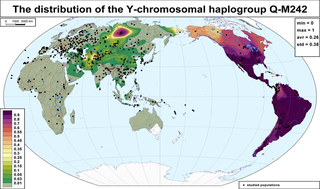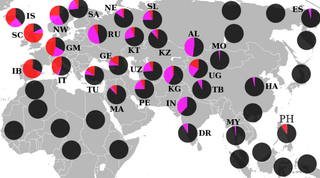Phylogeny
GHIJK is the major clade of Haplogroup F (F-M89). It branches subsequently into two direct descendants: Haplogroup G (M201/PF2957) and Haplogroup HIJK (F929/M578/PF3494/S6397). The other haplotypes of Haplogroup F are F1, F2, and F3.
Subclades of GHIJK, under the HIJK lineage, include: H (L901/M2939) and IJK (F-L15). The downstream descendants of Haplogroup IJK include the major haplogroups I, J, K, L, M, N, O, P, Q, R, S and T.

A haplotype is a group of alleles in an organism that are inherited together from a single parent, and a haplogroup is a group of similar haplotypes that share a common ancestor with a single-nucleotide polymorphism mutation. More specifically, a haplotype is a combination of alleles at different chromosomal regions that are closely linked and that tend to be inherited together. As a haplogroup consists of similar haplotypes, it is usually possible to predict a haplogroup from haplotypes. Haplogroups pertain to a single line of descent. As such, membership of a haplogroup, by any individual, relies on a relatively small proportion of the genetic material possessed by that individual.

Haplogroup J-M304, also known as J, is a human Y-chromosome DNA haplogroup. It is believed to have evolved in Western Asia. The clade spread from there during the Neolithic, primarily into North Africa, the Horn of Africa, the Socotra Archipelago, the Caucasus, Europe, Anatolia, Central Asia, South Asia, and Southeast Asia.

Haplogroup F, also known as F-M89 and previously as Haplogroup FT, is a very common Y-chromosome haplogroup. The clade and its subclades constitute over 90% of paternal lineages outside of Africa.

Haplogroup K or K-M9 is a genetic lineage within human Y-chromosome DNA haplogroup. A sublineage of haplogroup IJK, K-M9, and its descendant clades represent a geographically widespread and diverse haplogroup. The lineages have long been found among males on every continent except Antarctica.

Haplogroup M, also known as M-P256 and Haplogroup K2b1b is a Y-chromosome DNA haplogroup. M-P256 is a descendant haplogroup of Haplogroup K2b1, and is believed to have first appeared between 32,000 and 47,000 years ago.

Haplogroup Q or Q-M242 is a Y-chromosome DNA haplogroup. It has one primary subclade, Haplogroup Q1 (L232/S432), which includes numerous subclades that have been sampled and identified in males among modern populations.

Haplogroup R1, or R-M173, is a Y-chromosome DNA haplogroup. A primary subclade of Haplogroup R (R-M207), it is defined by the SNP M173. The other primary subclade of Haplogroup R is Haplogroup R2 (R-M479).

In human genetics, a human Y-chromosome DNA haplogroup is a haplogroup defined by mutations in the non-recombining portions of DNA from the male-specific Y chromosome. Many people within a haplogroup share similar numbers of short tandem repeats (STRs) and types of mutations called single-nucleotide polymorphisms (SNPs).

Haplogroup R, or R-M207, is a Y-chromosome DNA haplogroup. It is both numerous and widespread amongst modern populations.
Haplogroup IJ (M429/P125) is a human Y-chromosome DNA haplogroup, an immediate descendant of Haplogroup IJK. IJK is a branch of Haplogroup HIJK.

Haplogroup CT is a human Y chromosome haplogroup. CT has two basal branches, CF and DE. DE is divided into a predominantly Asia-distributed haplogroup D-CTS3946 and a predominantly Africa-distributed haplogroup E-M96, while CF is divided into an East Asian, Native American, and Oceanian haplogroup C-M130 and haplogroup F-M89, which dominates most non-African populations.

Haplogroup K2, also known as K-M526 and formerly known as K(xLT) and MNOPS, is a human Y-DNA haplogroup.

Haplogroup CF, also known as CF-P143 and CT(xDE), is a human Y-chromosome DNA haplogroup. CF is defined by the SNP P143, and its existence and distribution are inferred from the fact that haplogroups descended from CF include most human male lineages in Eurasia, Oceania, and The Americas. CF descends from CT (CT-M168), and is the sibling of DE. CF has two basal branches, Haplogroup C and Haplogroup F.
Haplogroup IJK is a human Y-chromosome DNA haplogroup. IJK is a primary branch of the macrohaplogroup HIJK. Its direct descendants are haplogroup IJ and haplogroup K.

Haplogroup R1b (R-M343), previously known as Hg1 and Eu18, is a human Y-chromosome haplogroup.
Haplogroup E-P147 is a human Y-chromosome DNA haplogroup. Haplogroup E-P147, along with the less common haplogroup E-M75, is one of the two main branches of the older haplogroup E-M96. The E-P147 clade is commonly observed throughout Africa and is divided into two subclades: the less common, haplogroup E-M132, and the more common, haplogroup E-P177.
In human population genetics, Y-Chromosome haplogroups define the major lineages of direct paternal (male) lines back to a shared common ancestor in Africa. Men in the same haplogroup share a set of differences, or markers, on their Y-Chromosome, which distinguish them from men in other haplogroups. These UEPs, or markers used to define haplogroups, are SNP mutations. Y-Chromosome Haplogroups all form "family trees" or "phylogenies", with both branches or sub-clades diverging from a common haplogroup ancestor, and also with all haplogroups themselves linked into one family tree which traces back ultimately to the most recent shared male line ancestor of all men alive today, called in popular science Y Chromosome Adam.

Haplogroup K2b (P331), also known as MPS is a human y-chromosome haplogroup that is thought to be less than 3,000 years younger than K, and less than 10,000 years younger than F, meaning it probably is around 50,000 years old, according to the age estimates of Tatiana Karafet et al. 2014.
Haplogroup HIJK, defined by the SNPs F929, M578, PF3494 and S6397, is a common Y-chromosome haplogroup. Like its parent macrohaplogroup GHIJK, Haplogroup HIJK and its subclades comprise the vast majority of the world's male population.

Haplogroup K2a is a human Y-chromosome DNA haplogroup. K2a is a primary subclade of haplogroup K2 (M526), which in turn is a primary descendant of haplogroup K (M9). Its sole primary descendant is haplogroup K-M2313.












